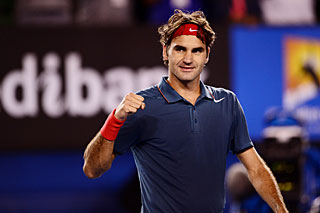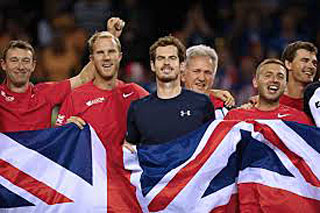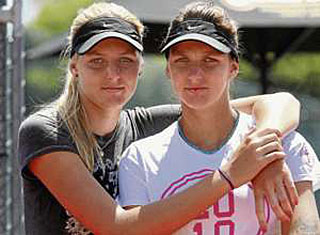|
TennisOne Lessons Serena and Novak Dominate the Year That Was Paul Fein Super teams and players dominated the sports headlines in 2015. Perennial powerhouse Barcelona ruled European football. Newcomer Jordan Spieth exploded to win two golf majors and finish second in two more. American Pharoah captured horse racing’s Triple Crown. And Golden State, after grabbing the NBA title in June, streaked to a phenomenal 24-0 start this season, the best in North American major sports history. Tennis boasted not just one Dominator, but two. Serena Williams and Novak Djokovic thrilled us with the best seasons since Steffi Graf’s “Golden Slam” in 1988. But which superstar had the better year? Even though not-so-serene Serena came oh so close—within two matches—of pulling off a rare Grand Slam, Novak outdid her. While Djokovic’s hopes for the first men’s Grand Slam since Rod Laver’s in 1969 were dashed much earlier than Williams’—in the French Open final—he accomplished more. The 28-year-old Serb won 11 titles (compared to five for Williams), including three majors, the ATP World Tour Finals, and a record six ATP Masters 1000 series crowns. He wound up 31-5 against top-10 opponents (compared to only 6-1 by Williams) and with nearly twice as many ranking points as No. 2 Andy Murray. Importantly, Djokovic also faced tougher competition against Murray, Roger Federer, Rafael Nadal, and Stan Wawrinka than Williams, whose 21 career major titles surpassed the total (20) achieved by the rest of the women’s tour. No wonder Djokovic called his season “as close to perfection as it can get” and “the best year of my life.” Williams’ quest to achieve a Grand Slam riveted sports fans, but she enjoyed it far less than the fun-loving Djokovic. “It’s hard and lonely at the top,” she confided to Vogue magazine. “Everyone wants to beat you. Everyone talks behind your back, and you get a lot more criticism. God forbid I lose. It’s like ‘Why?’ Well, I am human.” Indeed she was, as it turned out.
Consider the multi-faceted pressure Williams faced. Not only was she chasing the Grand Slam but also the most hallowed career record, the 24 major titles of Margaret Court. Physically, Serena was hampered by a bad cold at Melbourne and the flu at Roland Garros, as well as knee and elbow pain most of the year. Mentally, the toll was heavy, too. After every match she was peppered with questions about her historic quest by the media who often reminded her that at 33 she might not get another chance. Court would prove prophetic when, after winning the Grand Slam in 1970, she said: “More than anything, winning the Grand Slam is a battle within yourself. It really gets down to how you handle the pressure, more than how you handle anybody else.”
In the past, Williams almost always stared down pressure—and her “Take that!” glare had intimidated opponents after she belted awesome aces on pivotal points. She conquered the Australian Open, the French Open, Wimbledon, and five US Open foes. She had only two very beatable, aging Italians left on her plate to devour. But that eight-letter word, P-R-E-S-S-U-R-E devoured Williams instead. Collapsing nervously in an excruciatingly tense third set, Williams was upended in a 2-6, 6-4, 6-4 shocker by light-hitting, but clever, 5’4” Roberta Vinci, a pre-tournament 250-1 longshot. “This is absolutely the biggest major upset of all time,” said ESPN analyst Pam Shriver, a 1980s doubles star. Flavia Pennetta, a 150-1 longshot herself, then defeated her longtime friend Vinci for her first major title, and completed the surprise-filled tournament by announcing she would retire in October. Heartbroken and exhausted, Williams prematurely ended her sensational season with this memorable defeat, calling her journey “at times exhilarating, at times disappointing.” The stunning parity below Queen Serena is evidenced by 10 different runner-ups in the last 10 Grand Slam finals. In the highlight of her season, No. 4 Maria Sharapova gained the Australian final. But she bowed 6-3, 7-6 to Williams, Sharapova’s 17th straight loss to her bête noire. Victoria Azarenka’s comeback from a serious foot injury was steady but slow, and she rose to only No. 22. In fairness, she suffered some tough luck in potentially season-changing matches. A bad line call on set point cost Azarenka the second set of her 3-6, 6-4, 6-2 French Open setback against Williams; and a rain delay early in the third set stopped her momentum in her 6-3, 4-6, 6-4 US Open quarterfinal loss to Simona Halep. The stylish-stroking Halep wound up No. 2, a misleading ranking because she didn’t defeat any top-4 opponents and won just 10 total matches at the majors. No. 6 Petra Kvitova dealt Williams the most decisive of her three losses (6-2, 6-3 in Madrid) and brought massive power, but Kvitova lacked consistency and failed to make the semis at any major.
Two rising stars proved most impressive. Hard-hitting Spaniard Garbiñe Muguruza reached her first major final at Wimbledon and shot up from No. 24 to No. 3. Belinda Bencic didn’t advance past the fourth round at a major, but she can beat anyone. In Toronto, the 18-year-old Swiss Miss whipped former Wimbledon finalists Eugenie Bouchard and Sabine Lisicki, former No. 1s Ana Ivanovic and Caroline Wozniacki, Halep, and Williams for her biggest title. Wawrinka Breaks Into Big Four In the men’s game, Stan Wawrinka replaced slumping Nadal in the reigning Big Four by upsetting Djokovic in a high-caliber four-set final at the French Open. It remains the only major title Djokovic has yet to win. An inspired Wawrinka whacked 59 winners, almost twice as many as Djokovic, to grab his second major. Nicknamed “Stanimal,” Wawrinka also overpowered his Swiss compatriot Federer in a straight-sets semifinal.
Federer scoffs at skeptics who contend that he’s over the hill at 34. Bursting with confidence and enthusiasm, he said, “I think I’m a better player now than when I was 24 because I’ve practiced for another 10 years and I’ve got 10 years more experience.” With effortless, glorious shot-making, he finished No. 3 and beat Djokovic three times in eight encounters. Djokovic won all their most important matches, though—in the finals of Wimbledon, US Open, Indian Wells, and ATP Finals. The Mighty Fed plans to compete at least one more year, and he’s targeting an Olympic gold medal, the only prestigious title he hasn’t claimed, in Rio de Janeiro in August. Don’t count him out there or anywhere else. Nadal, Federer’s longtime archrival, not only failed to win a Grand Slam title for the first time since 2004—and still trails Federer 17-14 in Grand Slam titles—but reached only two quarterfinals. Even then, he was trounced by Tomas Berdych (who had lost their 18 previous matches!) in Melbourne and Djokovic in Paris. The best news for Rafa aficionados was a late-season resurgence highlighted by victories over Murray, Wawrinka twice, David Ferrer, Milos Raonic, Richard Gasquet, and Marin Cilic. Exuberant again, Nadal fist-pumped and let out cries of “Vamos! Vamos!” after he walloped vicious forehand winners. The doubles storylines featured the dethronement of Bob and Mike Bryan and the domination by another ageless Swiss, Martina Hingis. The 37-year-old Bryan twins, the greatest team in men’s doubles history, failed to capture a major for the first time since 2004. They were replaced at No. 1 by Dutchman Jean-Julien Rojer and Romanian Horia Tecau, champions at Wimbledon and the ATP Finals.
Hingis, 34, became the second all-time great—the other was also named Martina—to seize Grand Slam titles after enshrinement in the International Tennis Hall of Fame. She immediately clicked with two Indian doubles standouts. Hingis and forehand-bashing Sania Mirza smiled and romped to 10 titles, including Wimbledon, the US Open, Indian Wells, Miami, and the WTA Finals, to finish the season No. 1 riding a 22-match winning streak. Hingis rampaged even more in mixed doubles. She and another “golden oldie,” 42-year-old Leander Paes, outwitted and out-volleyed foes to grab three majors—the Australian, Wimbledon, and US titles. But not all the fun and games happened on the courts. Press conferences produced some juicy quotes. When Ernests Gulbis, who would play Nicolas Mahut in the French Open second round, was asked, “Specifically, what would you do before meeting Nicolas?” Gulbis answered, “I will sleep and I will eat specifically.” Musing on the agony of defeat, Federer said, “In tennis, always one guy has to win and one guy has to lose. One has got the press conference he dreads.” When Sharapova was told Williams’s coach Patrick Mouratoglou, whom Sharapova outed as Williams’s lover, had said, “Azarenka is much better than Sharapova,” Sharapova retorted, “I don’t think you’re ever going to hear nice words from him about me. I’m sure you know [why].” When surprise French Open quarterfinalist Alison Van Uytvanck was asked, “You played against a French player. Of course, fans were behind your opponent. How did you manage?” she replied, “I’m scared. There is a spider on the mic.” Asked why he cuddled a ball boy during his fourth-round Wimbledon loss to Gasquet, Nick Kyrgios explained, “I just felt like a hug, I guess. Everyone now and then wants a hug.” ***** ***** ***** ***** Here are some “Bests” and “Worst” about those players, events, issues, and trends that made 2015 the most exciting and eventful tennis year of the millennium.
Best Admission of Nerves — “Of course. I’ve had it and ended up losing the match. I don’t think I lost because I was nervous necessarily, but because of the circumstances. During a match, you have a very elevated pulse and you get the shakes sometimes, and you don’t know why that is. Sometimes your legs freeze, so you try to stay in the moment. That’s what I like about sports or tennis. When we get nervous, at least we’re moving and doing something, so we can distract our mind [with] physical effort.” — Roger Federer, asked by Inside Tennis magazine if he has suffered from his hands shaking or other forms of high anxiety at match point. Best USTA Player Development Strategy and Hires — Martin Blackman told the Associated Press that “a successful tennis federation model” seen in other countries, including Spain, France and Australia, blends “professional career coaches” with a "kind of organic retention of former players. We had a little break in that connection with the last generation of American champions. What we're trying to do now is be a little more systematic and strategic about getting all of our past champions involved and re-engaged.” Toward that highly desirable end, the USTA hired 1980s superstar Ivan Lendl, former world No. 7 Mardy Fish, and longtime tour player Jill Craybas. Best American Teenage Standouts — “I’m most excited about is not one player, but a group of five or six that are teenagers like [Jared] Donaldson and [Stefan] Kozlov and [Frances] Tiafoe and [Michael Mmoh] and Taylor Fritz and Tommy Paul. For the first time since I’ve been in this job, even going back before then, at least a decade or so, I think we've got a real strong group of teenagers. The nice thing is I don't think we're going to rely on just one. As we’ve seen historically, generally when you have a group of players, they can push each other, maybe take a little pressure off of each other as they develop from 16 until they make it to be fixtures on the tour.” — Former USTA player development chief Patrick McEnroe, now an ESPN commentator, telling Tennis.com in May that there is a good group of American teenagers coming up behind then No. 36 Jack Sock and No. 55 Steve Johnson.
Best Davis Cup Performer — Andy Murray became the first player to win eight live singles rubbers in a calendar year since the introduction of the World Group in 1981. He is just the third player to achieve an 8-0 World Group singles record in a calendar year. Murray is only the second player to win 11 live singles and doubles rubbers in World Group history after Croatia’s Ivan Ljubicic in 2005. He is the first player since Pete Sampras in 1995 to win three live rubbers in a Davis Cup Final. Murray led Great Britain to its first Davis Cup title since 1936 when he won two singles and a doubles with his brother Jamie in the Final against host Belgium. Best Azarenka Confidential — “I started with 40 kids in the hall where you are just hitting against the wall, and if you miss the ball, you wait for five minutes to hit another one, so you better make it. My first year, I didn’t even see the tennis court. My second year, we were on the court three times a week with 25 kids for one hour. That’s all. The rest is me going and hitting against the wall and imagining myself playing on the big arenas. When I see these kids 6 years old with a private coach and at 7 they have a fitness coach, I’m like, ‘Aw, come on.’ At 12, it’s for sure they will lose all the interest in tennis because they do not interact with other kids.” —Victoria Azarenka, attributing her fierce competitiveness to genetics and her childhood tennis experiences in Belarus, in The New York Times. Best Djokovic Confidential — “One of the biggest differences between tennis today and tennis 20 or 30 years ago is the media, which is all around you with smartphones giving you access to online news and social networks. All this stuff adds pressure, which you don’t need because it demands more energy from you. It’s a tough era to be in, but I’m proud of what I’ve achieved with my team. I know what it takes to be here.” —Novak Djokovic, talking to Sport Magazine (UK). Best Work Ethic Advice — “Most important is the work ethic and that the kids understand that it’s not the coach’s job to motivate them, or that if you win a junior tournament you’re actually great. … I left home at 14, stopped school at 16, and went on tour. I had a hard time understanding what hard work was, but eventually I figured it out. Early enough. That’s the key. If the kids don’t understand and don’t want to put in the hard work, they’ll never get anywhere.” —Roger Federer, when asked by Inside Tennis magazine what the recipe is for producing great American players. Best Praise For The Inside-Out Forehand — “The inside-out forehand is one of the most important shots in the game,” Roger Federer told The New York Times. “I look for every opportunity to do it.” If you ask guys what their favorite shot is, a lot would say the inside-out forehand.”
Best Points About Superiority of Two-Handed Backhands — “Berdych can sit back there and hit crosscourt backhands all day long. It’s really tough for a one-hander to compete with that. It’s tough to keep up with the pace with a one-handed backhand in this day and age. And it’s also tougher because you don’t have that stability on the serve return. Aesthetically, the one-hander is a beautiful thing. But if I played today, I’d go with two hands.” —Tennis Channel analyst and former doubles standout Corina Morariu, during the second set of Tomas Berdych’s 7-5, 6-4 victory over Grigor Dimitrov, who uses a one-handed backhand, at the If Stockholm Open. Best Fascinating Fact — Novak Djokovic boasts a terrific 27-2 career record in first-set tiebreakers at Grand Slam events. Best Bouchard Trivia — Slump-ridden Eugenie Bouchard, who started 2015 ranked No. 7 and finished at No. 48, changed coaches, agents, and physical trainers during the year. Best Keys Booster — “Madison is already a great player, and I think she’s going to win this tournament very soon and all the other Grand Slams as well. She pushed me really hard and I had to dig so deep mentally to get through. On all those match points she came up with so many great shots. She did so well when she was down and never gave up.” —Serena Williams, after she needed 10 match points to defeat Madison Keys 7-6, 6-2 in a heavy-hitting Australian Open semifinal that featured 13 aces by Williams and 12 by Keys.
Best Sibling Empathy — Karolina Pliskova, who advanced to the second round of the Australian Open, while her twin sister Kristyna, at No. 131 and ranked 110 places behind her, lost in the first round of the qualifying tournament, talked about the problems involved when her career skyrocketed while her sister’s career stalled. “They [people] are congratulating her if I win, and that’s not a really nice feeling,” empathized Karolina. “She’s losing, and I’m winning, and they say congrats to her. It’s tough, but it will be fine.” Best Judy Murray Anecdote about Andy and Jamie — “The story that always springs to mind was when they played against each other at a tennis tournament. I had taken a lot of children down from Scotland. I'm driving back in the mini-bus, it's quite dark and Andy has beaten Jamie in the final of this Under 12 event. They start having a fight in the back of the mini bus. Andy’s hand is over the back seat and eventually Jamie has taken enough and nails his fist into Andy's hand. There was blood and I had to stop the bus, we dress the wound, separate them and drive the few hours back. We had to take Andy for a tetanus shot because the nail was ripped and the nail has never grown in straight. But it's a reminder about being humble and never bragging about beating anyone, especially your brother!” —Judy Murray, telling CNN’s “Open Court” show about a fiery post-match exchange between her sons, Andy and Jamie, who played in the same singles tournaments in their younger years, and the moral of the story. Best Emotion — “I couldn't stop crying. So many people are clapping... I make all these people feel this in a tennis court? I felt special.” —Garbine Muguruza, who cried when she sat down after losing championship point to Serena Williams in the Wimbledon final and then cried again during the awards presentation, saying she was overcome by emotion when she received a standing ovation as she clutched the runners-up trophy. Best Apology — “I apologized on the air to both Italian women; I said, ‘I didn’t even give you guys a chance.’ We were all talking about a Serena-Halep final. For both of them to do it? It’s unbelievable. But this is the biggest.” —Chris Evert, on No. 43-ranked Roberta Vinci, who shocked Serena Williams 2-6, 6-4, 6-4 and No. 26 Pennetta, who upset No. 2 Simona Halep, 6–1, 6–3, in the day’s undercard match.” Best Analysis of Evolution of Women’s Tennis — “You can generalize and say the women are stronger, bigger, taller and more athletic. But it’s not like Lindsay Davenport’s serve was a tiny little thing. Mary Pierce hit very hard, and the Williams sisters have been around for 20 years. The difference today is that technology helps to provide the power and, for girls with a decent serve, allows them to turn it into a massive weapon.” — Eleven-time Grand Slam women's doubles winner Martina Hingis, now 34, contending that the new rackets allow her still to be competitive in doubles after twice retiring from the game, in The Times (UK). Best Analysis of Evolution of Men’s Tennis — “You could give them all wood rackets, and these guys are still bigger and stronger and faster [than players in previous eras]. You add the spins, you add the speed. You add the rules of engagement. The points are more ballistic than they’ve ever been, and they go longer than they've ever gone. These guys are playing to depletion. I mean, my word! It’s violent. Sprinting five miles in a match, there’s no jogging. I mean I played with urgency because I needed to raise the stakes and get to someone physically. These guys do it for five hours.” —Eight-time Grand Slam winner Andre Agassi, telling Reuters that Rafael Nadal’s brutality had broken new ground in the sport, ushering in an era of super-athletes. * * * * * Your comments are welcome. Let us know what you think about Paul Fein's article by emailing us here at TennisOne.
Paul Fein Paul Fein has received more than 30 writing awards and authored three books, Tennis Confidential: Today’s Greatest Players, Matches, and Controversies, You Can Quote Me on That: Greatest Tennis Quips, Insights, and Zingers, and Tennis Confidential II: More of Today’s Greatest Players, Matches, and Controversies. Fein is also a USPTA-certified teaching pro and coach with a Pro-1 rating, former director of the Springfield (Mass.) Satellite Tournament, a former top 10-ranked men’s open New England tournament player, and currently a No. 1-ranked Super Senior player in New England. |
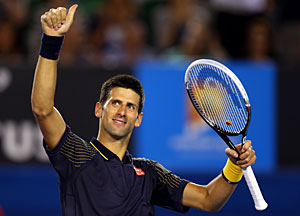
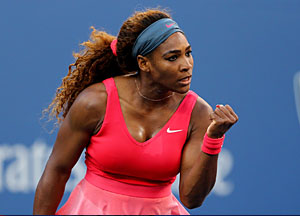
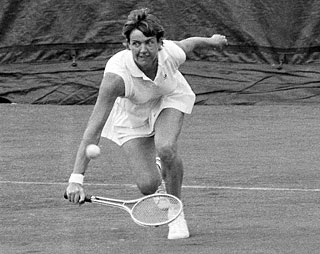
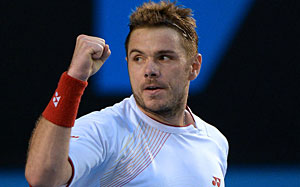
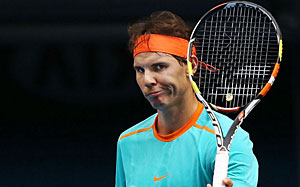
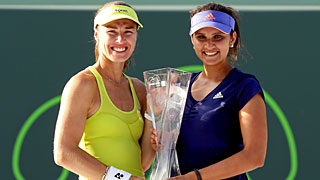 Martina Hingis, with the help of partners Sania Mirza and Leander Paes (not shown), firmly established herself as one of the greatest women's doubles players of all time.
Martina Hingis, with the help of partners Sania Mirza and Leander Paes (not shown), firmly established herself as one of the greatest women's doubles players of all time.